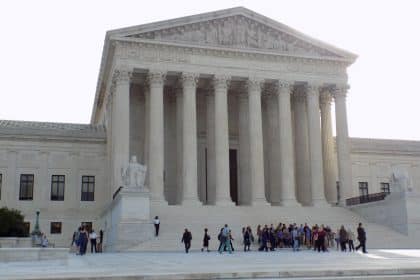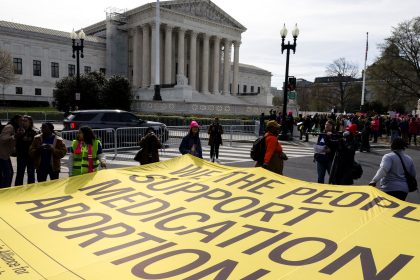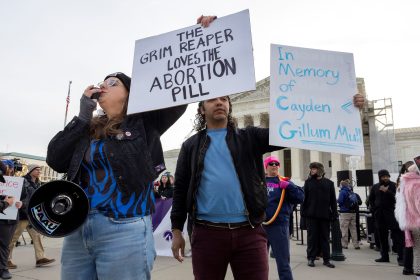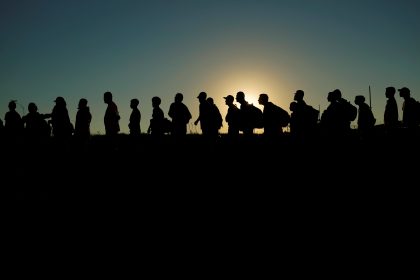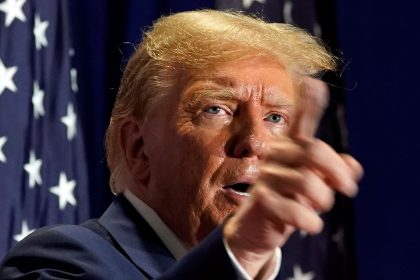Justices Significantly Expand Gun Rights in Major Second Amendment Ruling
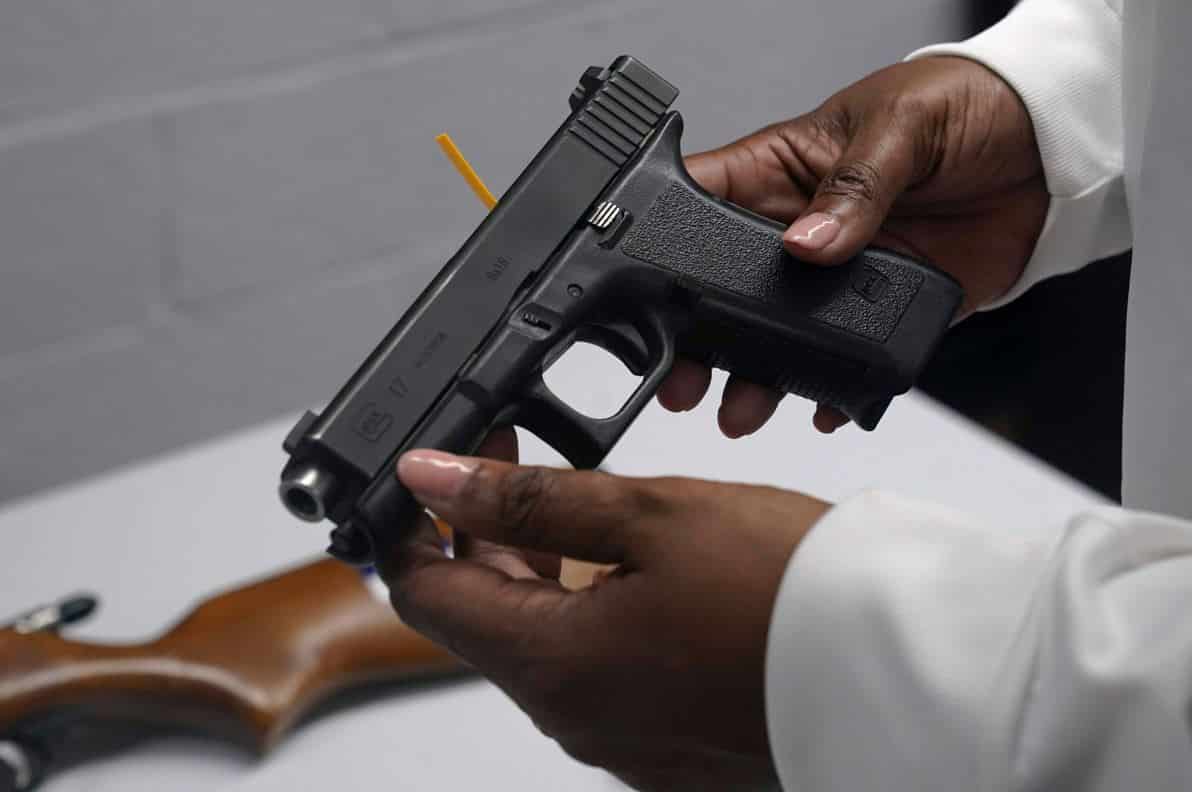
WASHINGTON — New York State’s “proper cause” requirement to obtain a concealed-carry license is unconstitutional because it prevents law-abiding citizens with self-defense needs from exercising their Second Amendment right to keep and bear arms for that purpose, a divided Supreme Court ruled on Thursday.
Writing for the majority in the 6-3 decision, Justice Clarence Thomas explained that nothing in the Second Amendment distinguishes between home and public spaces “with respect to the right to keep and bear arms.”
Thomas goes on in the 63-page opinion to say that in the view of the majority, “the Second and 14th Amendments protect an individual’s right to carry a handgun for self-defense outside the home.”
That rendered New York’s proper cause requirement unlawful because it allowed concealed or public carry licenses only when an applicant could show they had a special need to protect themselves.
In a concurring opinion, Justice Brett Kavanaugh wrote that the majority’s ruling “does not prohibit states from imposing licensing requirements for carrying a handgun for self-defense.”
“In particular, the court’s decision does not affect the existing licensing regimes — known as ‘shall-issue’ regimes — that are employed in 43 states,” he said.
Chief Justice John Roberts joined the concurring opinion.
It should be noted here that states take a variety of approaches when it comes to concealed carry licensing or permitting.
In a shall-issue state, if an applicant meets all the requirements to obtain a concealed carry license or permit, like firearms training and having submitted to a background check, the state must issue the license or permit. It has no discretion in the matter.
Other states have adopted a “may-issue” regime under which a state can withhold a concealed carry permit or license based on its own discretion, even if the applicant has passed a background check, had firearms training and met other requirements.
In Kavanaugh’s view, states “may continue to require licenses for carrying handguns for self-defense so long as those states employ objective licensing requirements like those used by the 43 shall-issue states.”
The case decided Thursday, New York State Rifle & Pistol Association Inc. v. Bruen, marks the first time in 11 years that the high court has handed down a significant Second Amendment ruling.
To obtain a license for the lawful possession of a firearm in New York State, a licensing officer must determine whether the applicant is of good moral character, lacks a history of crime or mental illness and that “no good cause exists” to deny the license request.
Until Thursday morning, applicants also had to show “proper cause” to lawfully carry a concealed handgun. Openly carrying a handgun is banned in New York State.
As written, the New York law left “proper cause” undefined, but a number of court rulings have codified a standard that an applicant must “demonstrate a special need for self-protection distinguishable from that of the general community or of persons engaged in the same profession.”
Simply having a desire to carry a concealed handgun would not constitute proper cause, according to a number of state court rulings.
Petitioners Robert Nash and Brendan Koch filed the lawsuit that led to Thursday’s decision after they were denied licenses to carry concealed handguns in public despite the fact their applications said their reason for applying was self-defense and that both had extensive safety training.
The licensing officers determined they had failed to show proper cause because they did not demonstrate “a special need for self-defense that distinguished [themselves] from the general public.”
Nash and Koch sued, arguing the state was violating their Second Amendment rights, but both a federal district court and the 2nd U.S. Circuit Court of Appeals ruled against them.
In its ruling, the 2nd Circuit said the Supreme Court’s previous decisions in District of Columbia v. Heller and McDonald v. Chicago clarified the Second Amendment guarantees “are at their zenith within the home,” but that governments have more leeway to regulate firearm possession outside of the home.
But the majority felt the 2nd Circuit and other federal courts have been misinterpreting the two cases when it came to analyzing gun legislation.
“Since Heller and McDonald, the Courts of Appeals have developed a ‘two-step’ framework for analyzing Second Amendment challenges that combines history with means-end scrutiny,” Justice Thomas wrote. “The court rejects that two-part approach as having one step too many.
“Step one is broadly consistent with Heller, which demands a test rooted in the Second Amendment’s text, as informed by history. But Heller and McDonald do not support a second step that applies means-end scrutiny in the Second Amendment context,” the justice continued.
“Heller’s methodology centered on constitutional text and history. It did not invoke any means-end test such as strict or intermediate scrutiny, and it expressly rejected any interest-balancing inquiry akin to intermediate scrutiny,” he added.
To clarify the matter further, Thomas noted that in both Heller and McDonald, the Supreme Court held that the Second and 14th Amendments protect an individual right to keep and bear arms for self-defense.
“Under Heller, when the Second Amendment’s plain text covers an individual’s conduct, the Constitution presumptively protects that conduct,” he wrote.
“To justify a firearm regulation the government must demonstrate that the regulation is consistent with the nation’s historical tradition of firearm regulation,” he said.
Referencing McDonald, Thomas conceded that “historical analysis can sometimes be difficult and nuanced, but reliance on history to inform the meaning of constitutional text is more legitimate, and more administrable, than asking judges to ‘make difficult empirical judgments’ about ‘the costs and benefits of firearms restrictions,’ especially given their ‘lack [of] expertise’ in the field.
“Federal courts tasked with making difficult empirical judgments regarding firearm regulations under the banner of ‘intermediate scrutiny’ often defer to the determinations of legislatures. While judicial deference to legislative interest balancing is understandable — and, elsewhere, appropriate — it is not deference that the Constitution demands here,” he said.
“The Second Amendment ‘is the very product of an interest balancing by the people,’ and it ‘surely elevates above all other interests the right of law-abiding, responsible citizens to use arms’ for self-defense,” he said.
In dissent, Breyer said the majority’s decision “rests upon several serious mistakes … the question before us concerns the extent to which the Second Amendment prevents democratically elected officials from enacting laws to address the serious problem of
gun violence. And yet the court today purports to answer that question without discussing the nature or severity of that problem.”
In 2020 alone, Breyer wrote citing Centers for Disease Control and Prevention Statistics, 45,222 Americans were killed by firearms, Further, he said, since the start of 2022, there have been 277 reported mass shootings.
“An average of more than one per day,” he wrote, adding later, “Worse yet, gun violence appears to be on the rise.”
After laying out the recent history of mass shooting in more detail, including those in Uvalde, Texas and Buffalo, New York, in recent weeks, Breyer said “The primary difference between the court’s view and mine is that I believe the [Second] Amendment allows states to take account of the serious problems posed by gun violence that I have just described.
“I fear that the court’s interpretation ignores these significant dangers and leaves states without the ability to address them,” he said.
In a concurrence with the Thomas opinion, Justice Samuel Alito took umbrage at Breyer’s commentary.
“In light of what we have actually held, it is hard to see what legitimate purpose can possibly be served by most of the dissent’s lengthy introductory section,” Alito wrote. “Why, for example, does the dissent think it is relevant to recount the mass shootings that have occurred in recent years?
“Does the dissent think that laws like New York’s prevent or deter such atrocities? Will a person bent on carrying out a mass shooting be stopped if he knows that it is illegal to carry a handgun outside the home? And how does the dissent account for the fact that one of the mass shootings near the top of its list took place in Buffalo? The New York law at issue in this case obviously did not stop that perpetrator,” Alito said.
Later, he took aim at Breyer’s concern that there are nearly 400 million guns in private hands in the United States, saying the retiring justice failed to explain “what this statistic has to do with the question whether a person who already has the right to keep a gun in the home for self-defense is likely to be deterred from acquiring a gun by the knowledge that the gun cannot be carried outside the home.
“While the dissent seemingly thinks that the ubiquity of guns and our country’s high level of gun violence provide reasons for sustaining the New York law, the dissent appears not to understand that it is these very facts that cause law-abiding citizens to feel the need to carry a gun for self-defense.”
“Though Heller concerned the possession of a handgun in the home, the key point that we decided was that ‘the people,’ not just members of the ‘militia,’ have the right to use a firearm to defend themselves,” Alito wrote. “And because many people face a serious risk of lethal violence when they venture outside their homes, the Second Amendment was understood at the time of adoption to apply under those circumstances.”
Thomas’s opinion notes that it is “settled” that states can prohibit the carrying of firearms into “sensitive places” such as “schools and government buildings,” but he said New York’s law went too far “because there is no historical basis for New York to effectively declare the island of Manhattan a ‘sensitive place’ simply because it is crowded and protected generally by the New York City Police Department.
“None of the historical limitations on the right to bear arms approach New York’s proper-cause requirement because none operated to prevent law-abiding citizens with ordinary self-defense needs from carrying arms in public for that purpose,” he said.
Immediately after the court’s opinion was released, New York Gov. Kathy Hochul spoke at a press conference at which she declared, “We are not powerless to respond to this.”
“It is outrageous that at a moment of national reckoning on gun violence, the Supreme Court has recklessly struck down a New York law that limits those who can carry concealed weapons,” the governor said.
‘We are closely reviewing our options – including calling a special session of the legislature,” she added. “Just as we swiftly passed nation-leading gun reform legislation, I will continue to do everything in my power to keep New Yorkers safe from gun violence.”
In a written statement, New York Attorney General Letitia James called the ruling “incredibly disappointing.”
“For more than a century, this law has protected New Yorkers from harm by ensuring that there are reasonable and appropriate regulations for guns in public spaces. … We will work with the Governor and Legislature to amend our licensing statute that will continue to protect New Yorkers,” she said.
Meanwhile, at the White House, President Joe Biden offered a mutted response.
“I am disappointed,” he said, adding there is “one little bit of solace.”
“The majority opinion has laid out that it affects not every state,” he said, referencing the ruling’s impact on on the “shall-issue” states described above.
“The gun laws in 40 of these states are still in place based on this decision. Not good enough. I think it’s a bad decision. I’m disappointed,” he said.
Others cheered the Supreme Court ruling.
“We are gratified that the high court has said there can be no bureaucratic prerequisite to exercising one’s constitutionally-protected right to bear arms,” said Alan M. Gottlieb, founder and executive vice president of the Second Amendment Foundation.
“For too many generations, New York’s requirement has been the vehicle by which the constitutional rights of average law-abiding citizens have been deprived under color of law,” he said.
“Government bureaucrats have routinely been arbitrary and all-too-eager to prevent honest people from having the means to defend themselves against violent crime outside of their homes,” Gottlieb continued.
“This pattern of exclusivity—allowing only those with wealth and political connections to legally carry guns in public—has been an affront to the constitution for decades, and now officials in a handful of other states with similar arbitrary requirements are on notice they can no longer perpetuate what amounts to an outrage against the constitution. We’ll see how this ruling affects eight other states with similar laws including California, Connecticut, Delaware, Hawaii, Maryland, Massachusetts, New Jersey and Rhode Island,” he concluded.
Dan can be reached at [email protected] and at https://twitter.com/DanMcCue.


















